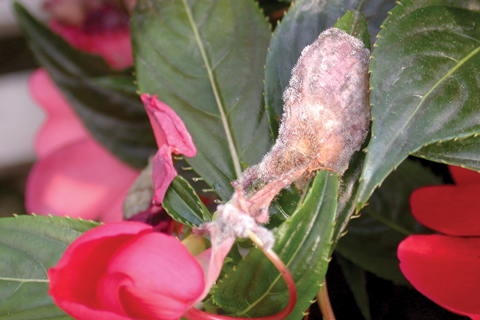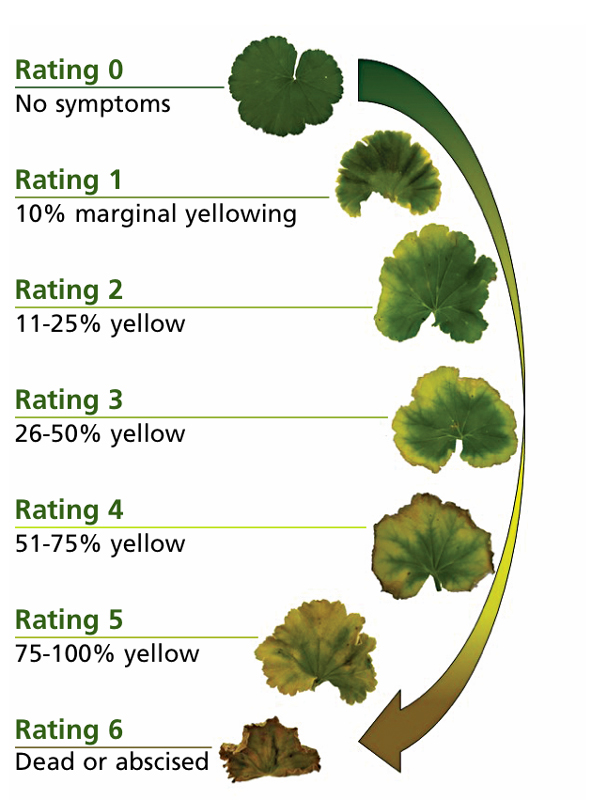11/1/2019
Botrytis on Geranium Cuttings: What the Latest Research Shows
Julie Martens Forney

The American Floral Endowment (AFE) helps growers solve real-world problems. Over the last several years, one topic AFE research has tackled relates to vegetatively propagated unrooted cuttings, exploring everything from growing stronger cuttings to controlling thrips on poinsettias to reviving wilted cuttings.
Dr. John Dole, North Carolina State University, helped lead some of the studies on unrooted cuttings. Why is studying cuttings important?
“Our work helps cutting suppliers harvest, store and ship cuttings more successfully, which in turn provides higher quality cuttings to rooting stations and growers,” he explained. “In one way, our work affects virtually all of the industry since we propagate so many of our bedding, potted flowering, cut and foliage species from cuttings.”
In this installment of AFE-funded research, his team’s work on shipping cuttings examines the interaction of shipping temperature, duration, humidity and ethylene on Botrytis disease development.
Botrytis basics
Botrytis is a generalist disease, boasting a very broad host range. With geraniums, it attacks both cuttings and the final potted plant.
“In greenhouses, there’s always a level of Botrytis present—the fungus spores,” John said. “If you dig down into a stock plant of geraniums or poinsettias, unless the grower has done a good job keeping them clean and removing dead leaves, the old leaves toward the bottom of the plant often have Botrytis.”
 All it takes is one dead leaf coated with fungal spores to infect healthy leaves.
All it takes is one dead leaf coated with fungal spores to infect healthy leaves.
“The one good thing is that Botrytis isn’t a terribly aggressive pathogen in terms of infecting healthy plant tissue. In fact, the healthy, vigorous leaves on top of the plant likely won’t get infected,” John explained. “Petals develop the disease quickly, though, so if a petal falls on a top leaf, Botrytis will eventually develop.”
Pictured: Topmost leaves on a stock plant aren’t likely to catch Botrytis from the lowest leaves, which are often loaded with fungal spores. But if a flower petal falls onto leaves, watch out. Petals develop Botrytis quickly and the disease will spread to leaves. Photo by Dr. John M. Dole.
For infection to develop, Botrytis usually needs a wound or senescing tissue for entry. It also needs free water for spores to germinate and warm, toasty air temperatures—conditions found in a greenhouse or a shipping box.
Most of the time, Botrytis problems on cuttings start during production.
“If plant material is infected during production, then that carries through to postharvest, with the main disease development occurring during shipping,” John said. “Pretty much any stored and stressed plant tissue is going to have a problem—and cuttings in a box are stored and stressed. A box is a great environment for Botrytis to develop.”
That’s why John and his team tackled this study. Is there a way to help cuttings navigate shipping channels without developing Botrytis? Do temperature and humidity inside shipping boxes determine how fast Botrytis takes hold? Or does it all come down to time spent in boxes?
Shipping, temperature & leaf yellowing
Like poinsettias and chrysanthemums, geranium cuttings tend to develop yellow leaves during shipping. The color change is a clue that cuttings are actively respiring inside boxes and using their limited stores of carbohydrates. The yellow tissue is weakened, though, and more susceptible to Botrytis infection.
Recommended shipping temperatures for geranium cuttings are 35 to 50F (1 to 10C), a range that slows respiration, reduces leaf yellowing (it halts at 35F) and avoids Botrytis growth. But in reality, temperatures shift during shipping, as boxes of cuttings move in and out of planes, sit on airport tarmacs or sit unprocessed at their final destination.
“If cuttings could ship entirely via refrigerated trucks, the temperature variability would be removed from the equation,” John said.
 As it is, offshore production means temperature fluctuations are a reality. As soon as cuttings are put into a box, the timer starts. The goal? Get cuttings from propagation greenhouse to rooting in less than two days. In the study, meeting that 48-hour target overcame a temperature swing as wide as 39 to 82F (3 to 27C). After two days? Leaf yellowing developed at all temps, including the ideal range.
As it is, offshore production means temperature fluctuations are a reality. As soon as cuttings are put into a box, the timer starts. The goal? Get cuttings from propagation greenhouse to rooting in less than two days. In the study, meeting that 48-hour target overcame a temperature swing as wide as 39 to 82F (3 to 27C). After two days? Leaf yellowing developed at all temps, including the ideal range.
Another thing that leads to yellow leaf tissue is ethylene. When cuttings go into boxes, they’re respiring—actively growing.
“As the cuttings grow, they produce more ethylene receptor sites and ethylene causes tissue to yellow,” John explained. Luckily, 1-MCP (1-methylcyclopropene) can be used to block ethylene.
Pictured: Geranium cuttings develop yellow leaves during shipping as temperature increases, as ethylene levels rise, but especially as shipping duration extends beyond the 48-hour mark. Yellow leaf tissue is weak and more susceptible to Botrytis infection. Graphic by Nathan J. Jahnke.
Humidity comes into play because Botrytis spores need water to germinate. They don’t need a puddle of water—a thin layer will do. Propagators cool cuttings prior to packing, but as soon as that box hits an airport runway or cargo hold, temperatures creep. Changing temperatures cause condensation to form on leaf surfaces and Botrytis can begin its march toward moldy glory.
In this study, after packing cuttings with dry leaves and boxing them, humidity increased an average of 23.5% within three hours. Humidity stayed high during shipping, averaging 91%. Yet even with that high humidity, when shipping completed within a two- to three-day window, cuttings didn’t develop Botrytis. This suggests that propagators can really help with Botrytis control by growing clean and shipping dry.
Recommendations for cutting producers
Clean, disease-free stock is key to preventing Botrytis on geranium cuttings. Rely on these methods to control Botrytis:
• Use active air movement. Even small air movement pulls away that very thin layer of high humidity next to leaf surfaces, which makes it hard for Botrytis to grow.
• Water with care. Keep leaves dry when watering by using drip or subirrigation.
• Remove dead leaves. Check plants regularly, looking toward the bottom and inside of the plant, where dead or dying leaves are easily overlooked.
• Pack cuttings cool. Processing areas should be winter-coat cool.
• Add ice packs. It’s tough to get the heat out of cuttings once they’re in bags. Ice packs in boxes can help.
• Keep shipping short. Aim to get cuttings to their destination within 24 to 48 hours to beat Botrytis and leaf yellowing.
What’s next for Botrytis treatment?
John believes that gene editing using CRISPR technology will likely change plants so they’re no longer sensitive to Botrytis.
“One of our faculty was working on the gene MTD, which activates a plant’s response to Botrytis,” he said. “We put it into rose and geranium, and it did delay Botrytis infection. It didn’t stop Botrytis or make the plant resistant, but it delayed infection by about two days, which means cut flowers like roses or geranium cuttings could be protected during
transit.
“Of course, there’s much work to do and CRISPR will have to be approved as a method for manipulating a plant genome. But it’s exciting to think about.” GT
University researchers like the team behind this study are eager to tackle industry issues. AFE welcomes feedback and suggestions from the industry to help identify key research needs. Also consider a tax-deductible contribution to the American Floral Endowment—it’s an investment with a terrific return. Industry-funded research benefits every grower when AFE is behind it. Reports on unrooted cutting studies and other AFE-funded research are available at endowment.org.
Julie Martens Forney is a freelance writer with more than 25 years of experience writing about floriculture industry issues and gardening for consumers. To read her current bylines, check out SAF’s Floral Management, HGTV.com and DIYNetwork.com. Julie’s also an avid gardener, tending edibles and perennials in a wildlife-friendly garden that features year-round color.